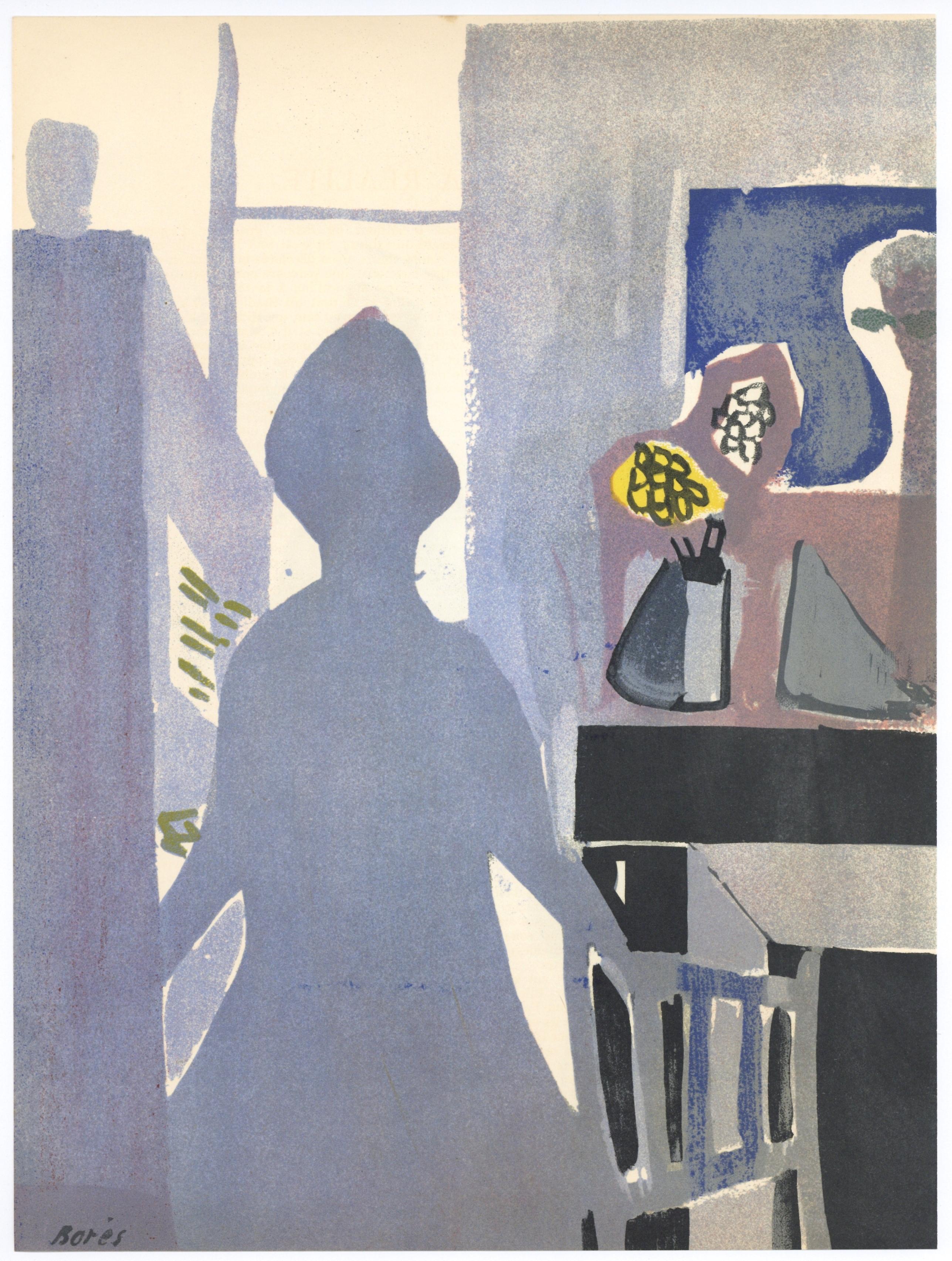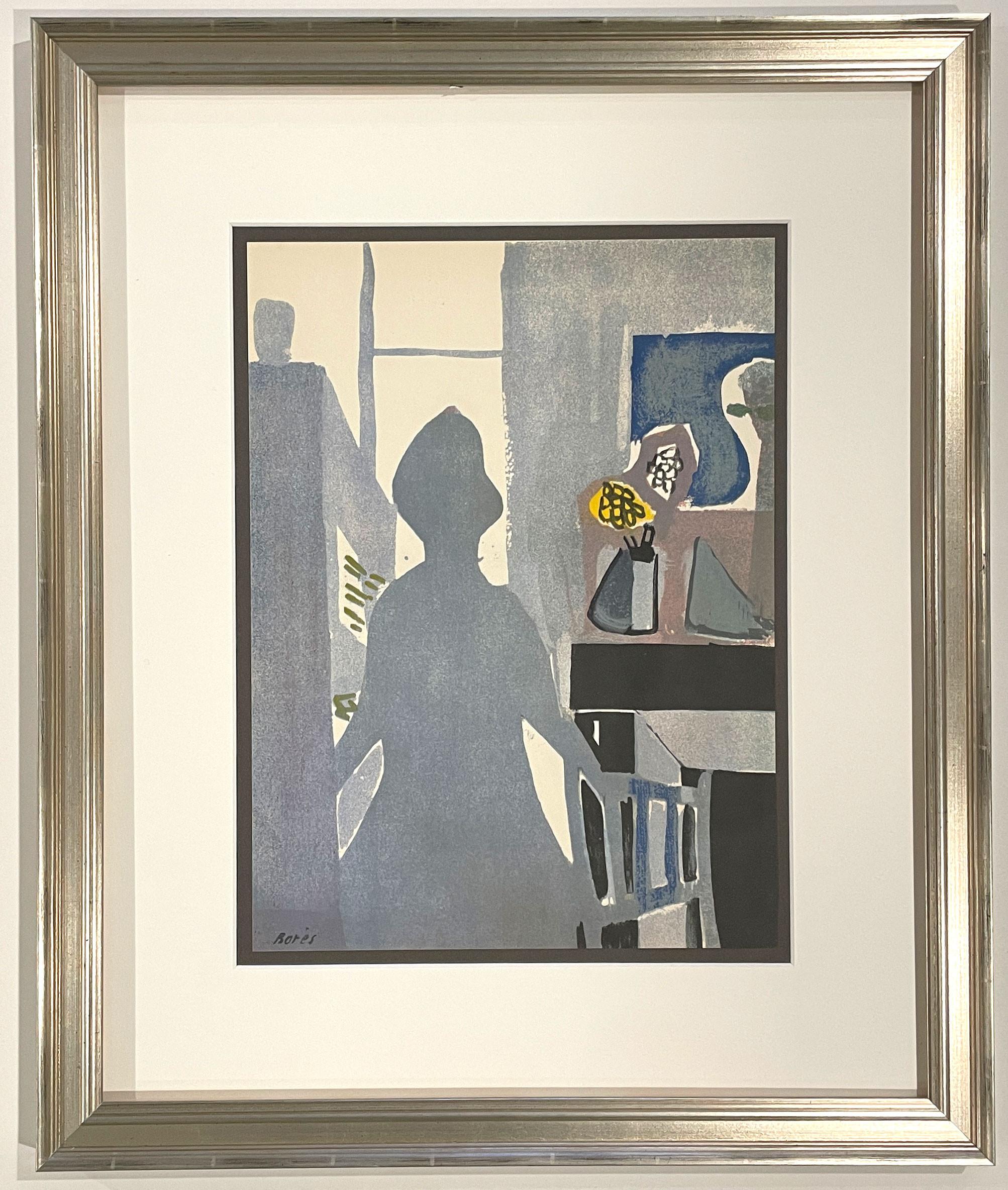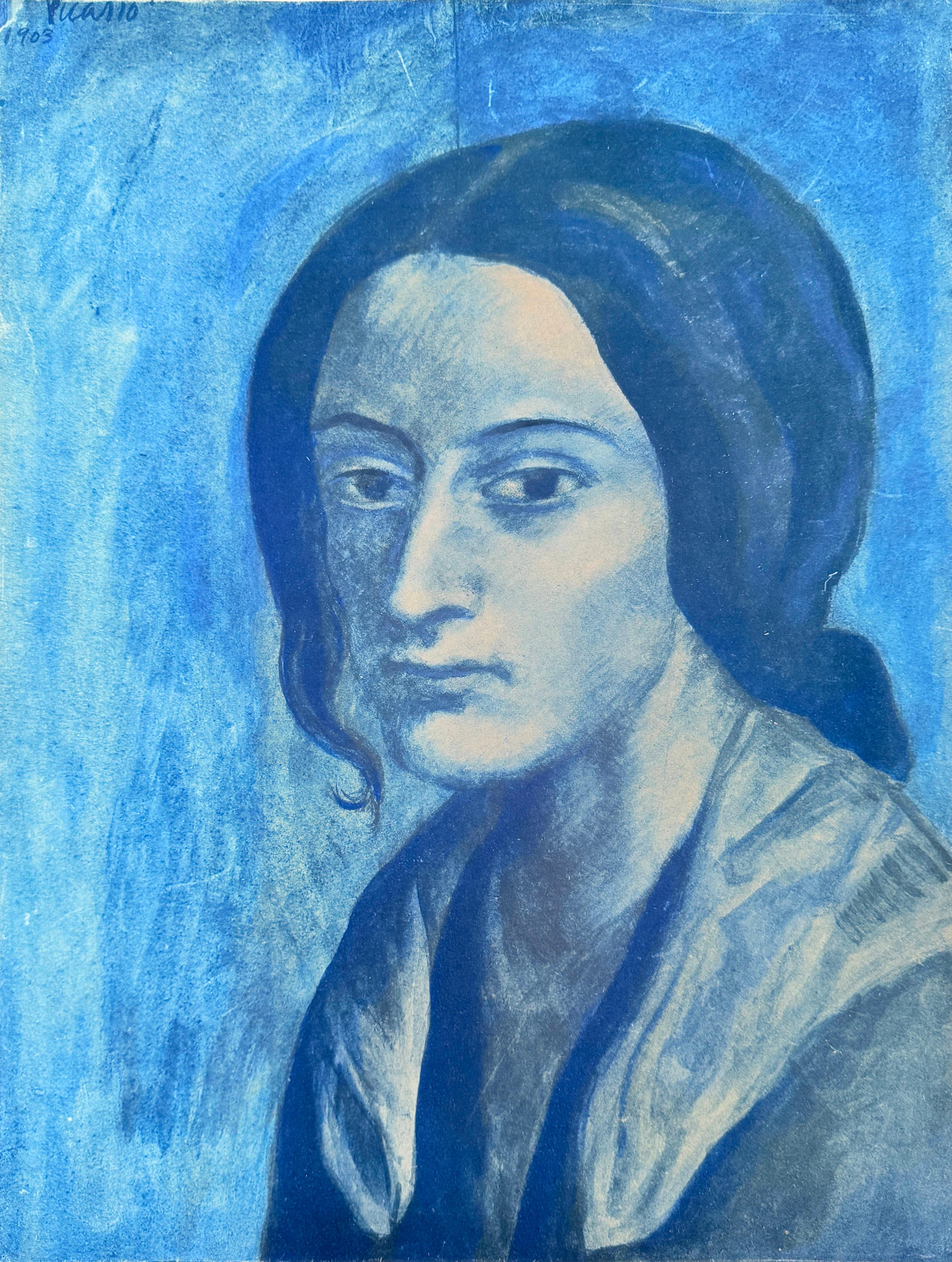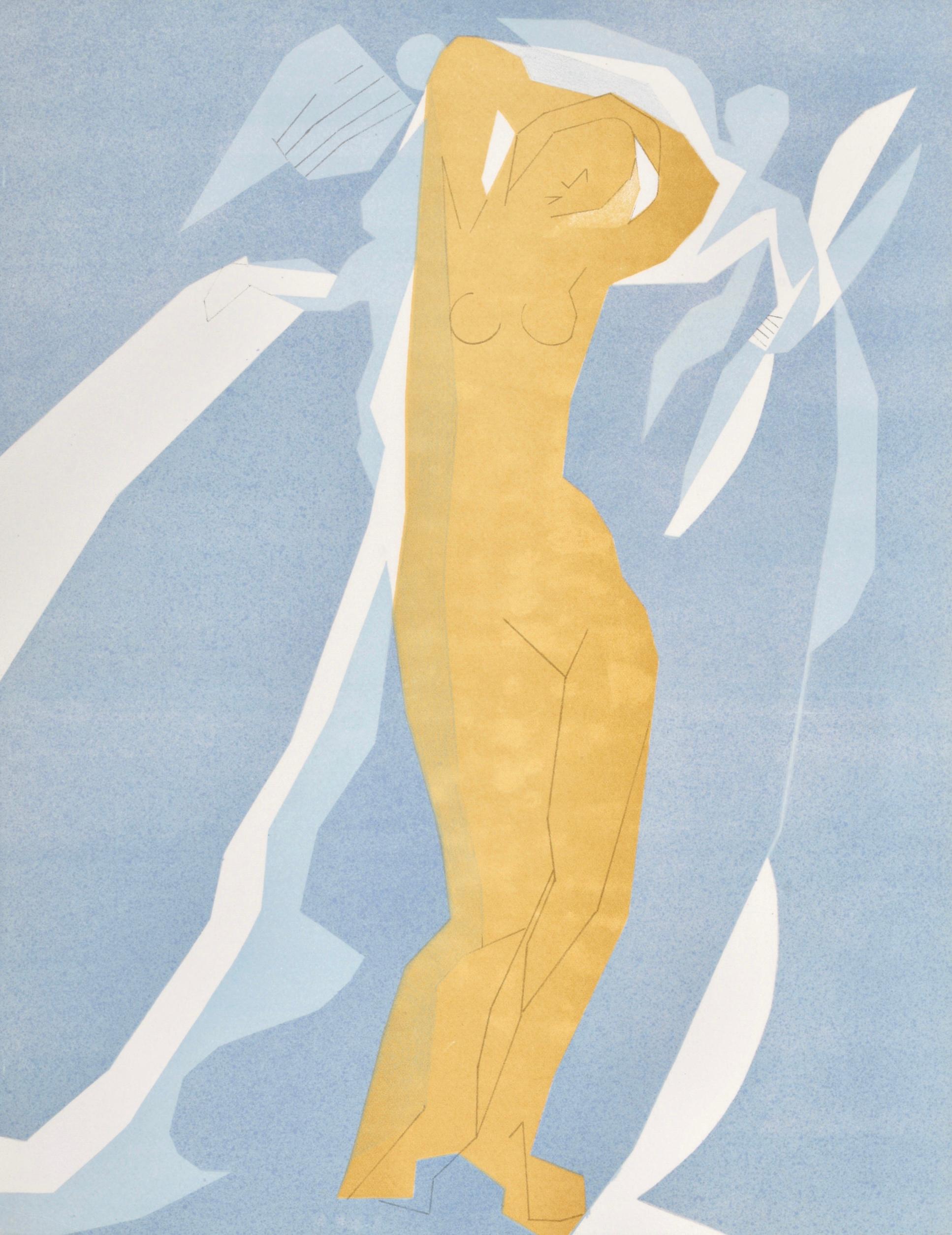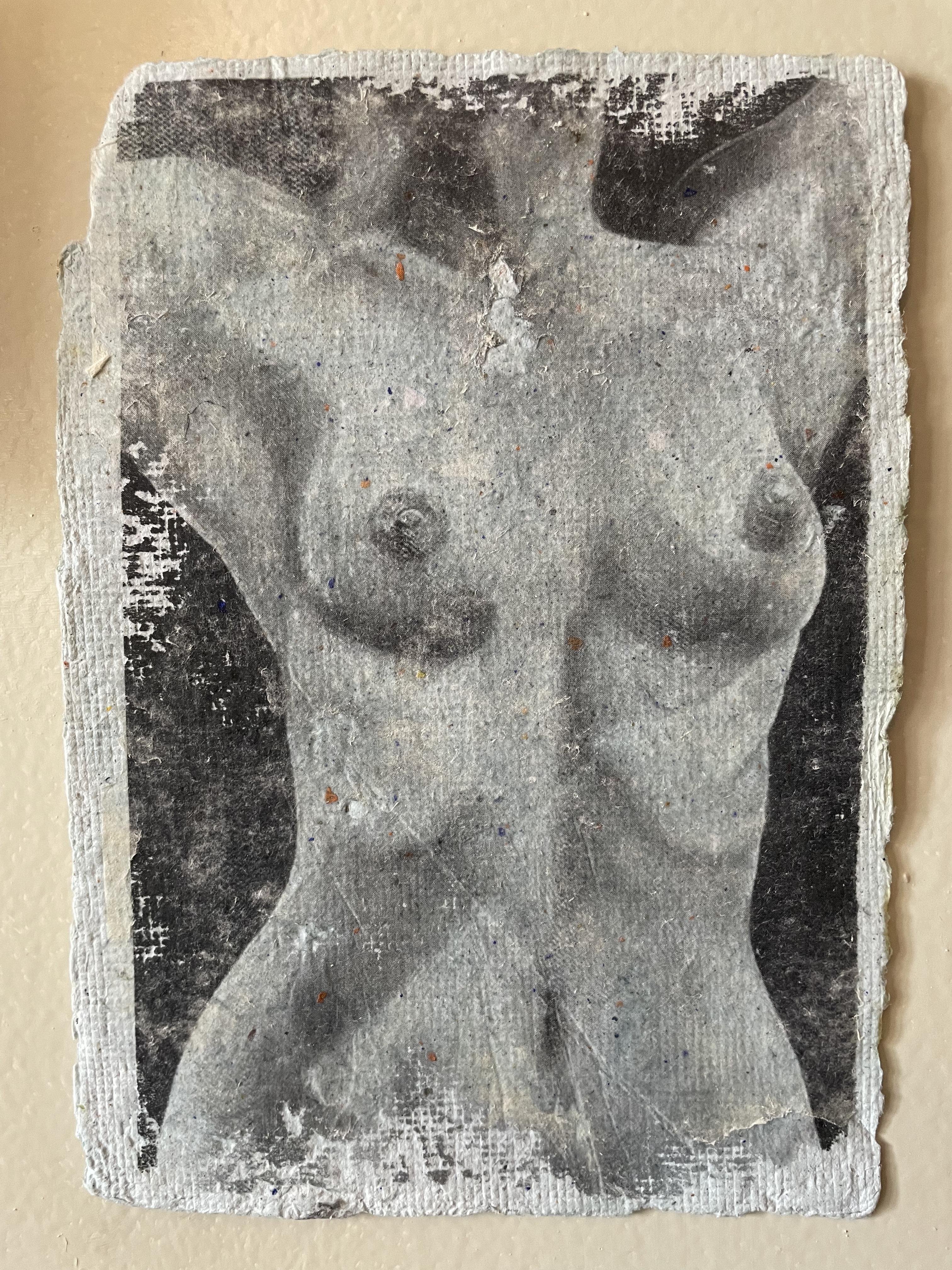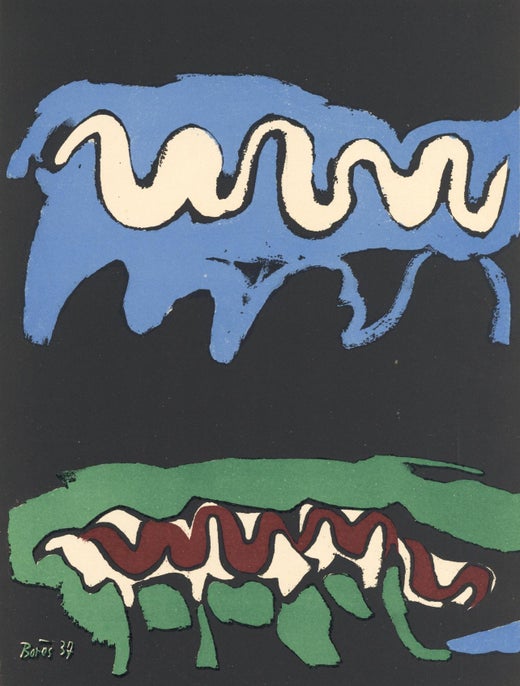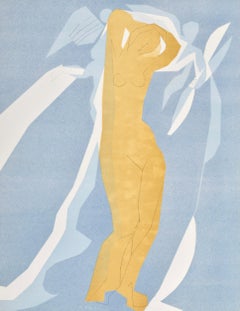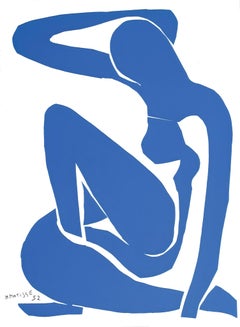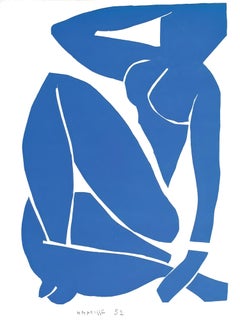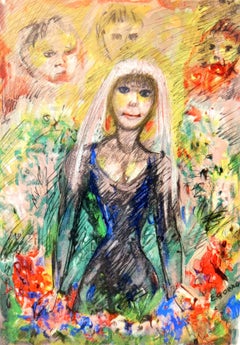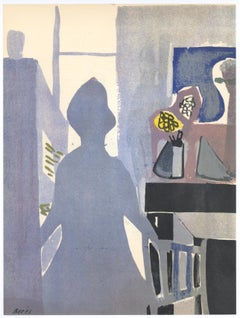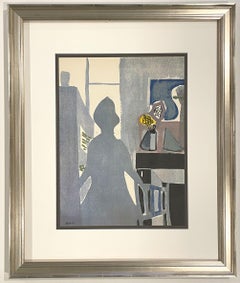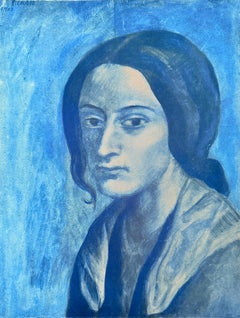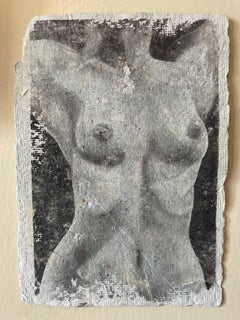Articoli simili a La Femme en Bleu, Verve: Revue Artistique et Littéraire
Vuoi altre immagini o video?
Richiedi altre immagini o video al venditore
1 di 11
Francisco BoresLa Femme en Bleu, Verve: Revue Artistique et Littéraire1953
1953
621,94 €
777,43 €20% in meno
Spedizione
Recupero del preventivo…La promessa 1stDibs:
Garanzia di autenticità,
Garanzia di rimborso,
Annullamento entro 24 ore
Informazioni sull’articolo
Litografia su carta vélin des Papeteries du Marais. Formato carta: 14 x 10,25 pollici. Iscrizione: Firmata nel piatto e non numerata, come da edizione. Note: Dall'album Verve: Revue Artistique et Littéraire, Vol. VII, N° 27-28, 1953. Pubblicato da Éditions de la revue Verve, Parigi, sotto la direzione di Tériade, éditeur, Parigi; stampato da Mourlot Frères, Parigi, 15 gennaio 1953, in un'edizione di MM. Estratto dall'album (tradotto dal francese), Questo numero doppio di Verve è stato completato per la stampa il 15 gennaio 1953 da Draeger per la tipografia e la rotocalco e da Mourlot per la litografia. Note aggiuntive: Estratto da Poppy Sfakianaki, 'La revue Verve (1937-60): Un tremplin pour la carrière de Tériade dans les éditions d'art', Journal of European Periodical Studies, 4.2 (Winter 2019), 70-89, Nel 1937, Tériade (1897-1983) incontrò David David (1892-1952), l'editore americano della rivista Esquire, che gli offrì l'opportunità di collaborare alla creazione della "rivista più bella del mondo". Smart riconobbe in Tériade non solo la sua abilità come editore e la sua conoscenza della storia dell'arte, ma anche la sua rete professionale e il nome che si era fatto nel mondo dell'arte parigino, tutti vantaggi cruciali per un'azienda editoriale. Avendo la convinzione commerciale che la bellezza "vende", Smart intendeva rivolgersi al pubblico americano, attratto dall'arte francese, compresa quella moderna, e dal mito della vita artistica di Parigi. Da parte sua, Tériade vide la proposta di collaborazione come un'opportunità per entrare nel mercato americano, un potente alleato dell'arte moderna in Francia. Le Éditions de la Revue Verve furono fondate nel novembre del 1937, finanziate in gran parte da Smart e dirette da Tériade. Verve: Revue Artistique et Littéraire era una lussuosa e ambiziosa pubblicazione d'arte, pubblicata non solo in francese, ma anche in inglese nei primi anni, e distribuita in Europa e negli Stati Uniti. La sua configurazione ricorda quella delle riviste d'arte francesi Cahiers d'art, Minotaure e Arts et métiers graphiques, nonché quella della rivista d'arte americana Coronet. Tuttavia, Verve era superiore alla concorrenza grazie alla sua ricca iconografia e all'elevata qualità di stampa. Il suo prezzo variava tra i 60 e i 150 franchi (per i numeri doppi) prima della guerra e tra i 120 e i 350 franchi durante la guerra. Dato il suo prezzo elevato, la rivista si rivolgeva principalmente a mercanti d'arte, collezionisti, bibliofili e ricchi amanti dell'arte. La squisita estetica della rivista era dovuta al suo caporedattore, Tériade, che cercava di sviluppare una piattaforma di dialogo tra immagine e testo, arti visive e letteratura. Il fattore dominante di ogni numero rimane l'iconografia, composta da riproduzioni di opere di artisti moderni che Tériade ammirava e di "maestri", principalmente della tradizione francese, accanto a foto e miniature di manoscritti medievali. Tériade ha indubbiamente realizzato con la sua rivista un'idea espressa nel 1934, secondo la quale i libri servivano come un "museo ideale" o una mostra in cui sono raccolti tutti i capolavori artistici, che Malraux sviluppò in seguito in Le Musée imaginaire (Ginevra: Skira, 1947), alcune parti del quale appariranno in Verve. Durante la Seconda Guerra Mondiale la periodicità della rivista cambiò, diventando irregolare, e la natura degli argomenti trattati fu meno varia. Così, i numeri pubblicati durante la guerra (così come nel 1945 e nel 1946) furono dedicati esclusivamente alla riproduzione di miniature medievali. Infine, i numeri speciali del dopoguerra presentano ciascuno la produzione recente di un pittore d'arte moderna. Solo i numeri 8 (1940) e 27-28 (1952) rappresentano un'eccezione con un sommario più vario. L'accoglienza di Verve è stata positiva, come dimostrano diversi articoli di stampa elogiativi durante tutta la sua durata. Il successo della rivista, la passione di Tériade per l'arte moderna e i manoscritti medievali, la sua ammirazione per le pubblicazioni di Ambroise Vollard e Albert Skira e la sua conoscenza del mondo dei bibliofili, lo portarono presto ad amplificare la sua attività editoriale. Nel 1943, nonostante le difficoltà pratiche imposte dalla guerra, viene pubblicato il suo primo libro d'artista, scritto e illustrato da Georges Rouault. Fino al 1975, Tériade pubblicò le Éditions de la Revue Verve, nove libri di artisti moderni, come Henri Matisse, Pablo Picasso, Marc Chagall, Joan Miró, interamente composti (testo e immagini) dagli artisti; diciassette libri illustrati da artisti moderni riconosciuti; un album di litografie di Fernand Léger su Parigi; due album fotografici di Henri Cartier-Bresson; due monografie sugli artisti André Beaudin e Francisco Borès; una lussuosa serie di riproduzioni di miniature medievali e una serie di portfolio sulla grande architettura francese. In definitiva, lo studio comparativo della rivista e delle edizioni di Verve: Revue Artistique et Littéraire illustra l'importanza della dinamica relazionale tacita che deriva dai rapporti di collaborazione e dallo scambio di capitale simbolico basato su percezioni e interessi comuni, nonché sui sentimenti di amicizia e apprezzamento reciproco degli attori del mondo dell'arte che condividono una cultura visiva e bibliofila e che quindi contribuiscono al successo della rivista e della casa editrice.
Francisco Bores (1898-1972) è stato una figura importante dell'arte europea del XX secolo. La sua presenza fu importante tra la seconda ondata di artisti spagnoli che arrivarono a Parigi negli anni '20, che comprendeva anche Pablo Picasso, Ginés Parra, Pedro Flores, Antoni Clavé; anche se nel suo paese non fu veramente riconosciuto fino agli anni '70, quando gli aspetti del suo lavoro che non si adattavano all'informalismo e al realismo sociale dominanti furono finalmente valorizzati. Lo stile di Bores è stato forgiato in seguito al suo stretto contatto con i più grandi pittori della prima Avanguardia: Pablo Picasso ed Henri Matisse. Ammirava il loro modo di costruire le forme, il classicismo e più tardi l'esplosione cubista. Bores armonizza queste influenze nel suo lavoro e le supera. Le sue opere sono esposte al Museo de Arte Contemporáneo di Madrid.
- Creatore:Francisco Bores (1989 - 1972, Spagnolo)
- Anno di creazione:1953
- Dimensioni:Altezza: 35,56 cm (14 in)Larghezza: 26,04 cm (10,25 in)
- Tecnica:
- Movimento e stile:
- Periodo:
- Condizioni:
- Località della galleria:Auburn Hills, MI
- Numero di riferimento:1stDibs: LU1465216383682
Francisco Bores
Francisco Bores López (Madrid, 5 maggio 1898 - Parigi, 10 maggio 1972) è stato un pittore spagnolo della cosiddetta Nuova Scuola di Parigi. La sua formazione artistica ebbe origine sia nell'accademia di pittura di Cecilio Pla, dove conobbe Pancho Cossío, Manuel Ángeles Ortiz o Joaquín Peinado, sia negli incontri letterari di Madrid legati all'ultraismo. In questo periodo realizzò incisioni e xilografie per un gran numero di riviste come Horizonte, Cruz y Raya, Index, Revista de Occidente. Nel 1922 partecipò all'Esposizione Nazionale di Belle Arti. Nel 1925 partecipò alla prima mostra della Società degli Artisti Iberici. Lo scarso successo di questa mostra lo spinge a recarsi a Parigi. In questa città condivise lo studio con il pittore spagnolo Pancho Cossío e conobbe anche Picasso e Juan Gris. Nel 1927 tenne la sua prima mostra personale a Parigi. Da questo momento in poi, Bores si integra nell'ambiente artistico parigino dove vivrà praticamente tutta la sua vita. Nel 1928, la sua prima mostra in una galleria negli Stati Uniti, nel 1930 espone nuovamente, all'interno di una mostra collettiva al Museum of Modern Art di New York. Negli anni successivi continuò a esporre in diverse gallerie di Parigi, come la Galleria Georges Petit, la Galleria Bernheim e la Galleria Vavin Raspail. Partecipa anche a diverse mostre collettive, tra cui spicca la Mostra di Arte Contemporanea Spagnola al Museo Jeu de Paume di Parigi; illustra inoltre libri e riviste d'arte come Minotauro. Contratti con le Gallerie Zwemmer di Londra e Galerie Simon di Parigi. Mostre negli Stati Uniti, presso la Buchholz Gallery di New York. Trascorse la Seconda Guerra Mondiale a Saint Jean de Luz dove riprese l'amicizia con Matisse. Nel 1947 lo Stato francese acquistò per la prima volta un'opera di Bores, mentre nel 1949 fu il Museum of Modern Art di New York ad acquistare i suoi dipinti. La sua attività espositiva riprende in tutta Europa: Francia, Germania, Danimarca, Italia. Spicca il suo inserimento tra i pittori della Galleria Louis Carré, una delle più prestigiose di Parigi, e quindi del mondo, in quegli anni (1954). Continua, sporadicamente, a illustrare libri (cinque linoleografie "Il grido per la morte di Ignacio Sánchez Mejias" di Federico García Lorca, litografie per illustrare l'opera completa di Albert Camus pubblicata dall'Imprimerie nationale francese nel 1962). Nel 1969 espose alla Galleria Theo di Madrid ciò che rappresentava il suo approccio al pubblico spagnolo, che praticamente non conosceva il suo lavoro se non negli ambienti professionali dove, invece, era molto apprezzato. Nel 1971 espone nuovamente in questa stessa Galleria Theo e muore a Parigi nel 1972. Nell'opera di Bores, il critico Joaquín de la Puente evidenzia diversi periodi: Rinnovato classicismo (1923-1925)
Neo cubismo (1925-1929)
Pittura-Frutta (1929-1933)
Scene di interni (1934-1949)
Stile in bianco (1949-1969)
Informazioni sul venditore
4,9
Venditore Platino
Venditori Premium con valutazione 4.7+ e tempi di risposta entro 24 ore
Fondazione nel 1978
Venditore 1stDibs dal 2021
1151 vendite su 1stDibs
Tempo di risposta standard: <1 ora
- SpedizioneRecupero del preventivo…Spedizione da: Auburn Hills, MI
- Politica di reso
Alcune parti di questa pagina sono state tradotte automaticamente. 1stDibs non può garantire che le traduzioni siano corrette. L’inglese è la lingua predefinita del sito.
Garanzia di autenticità
Nell’improbabile caso in cui si verifichi un problema con l’autenticità di un articolo, contattaci entro un anno per ottenere un rimborso completo. DettagliGaranzia di rimborso
Se il tuo articolo non corrisponde alla descrizione, è danneggiato durante il trasporto o non arriva, contattaci entro 7 giorni per un rimborso completo. DettagliAnnullamento entro 24 ore
Hai un periodo di tolleranza di 24 ore per annullare il tuo acquisto, senza necessità di fornire spiegazioni.Venditori professionali selezionati
I nostri venditori di livello internazionale devono aderire a rigorosi standard di servizio e qualità, garantendo l’integrità delle inserzioni.Garanzia miglior prezzo
Se scopri che un venditore ha pubblicato altrove lo stesso articolo a un prezzo più basso, applicheremo lo stesso prezzo.Consegna globale affidabile
La nostra rete di vettori leader del settore offre opzioni di spedizione specializzate in tutto il mondo, inclusa la consegna personalizzata.Altro da questo venditore
Mostra tuttoNu de femme en jaune et bleu, Regards sur Paris, André Beaudin
Di Andre Beaudin
Litografia su carta vélin d'Arches. Iscrizione: non firmata e non numerata, come emessa. Buone condizioni. Note: dal folio, Regards sur Paris, 1963. Pubblicato da André Sauret, Parig...
Categoria
Anni 1960, Moderno, Stampe (paesaggio)
Materiali
Litografia
899 € Prezzo promozionale
20% in meno
Spedizione gratuita
Matisse, Nu Bleu VI (Duthuit 139), Verve: Revue Artistique (dopo)
Di Henri Matisse
Litografia su carta vélin du Marais. Iscrizione: Non firmato e non numerato, come emesso. Buone condizioni. Note: Dal volume Verve: Revue Artistique et Littéraire, Vol. IX, N° 35-36,...
Categoria
Anni 1950, Moderno, Stampe (paesaggio)
Materiali
Litografia
1247 € Prezzo promozionale
20% in meno
Spedizione gratuita
Matisse, Nu Bleu IX (Duthuit 139), Verve: Revue Artistique (dopo)
Di Henri Matisse
Litografia su carta vélin du Marais. Iscrizione: Non firmato e non numerato, come emesso. Buone condizioni. Note: Dal volume Verve: Revue Artistique et Littéraire, Vol. IX, N° 35-36,...
Categoria
Anni 1950, Moderno, Stampe (paesaggio)
Materiali
Litografia
La mariée, Vingt fables de La Fontaine, Edouard Goerg
Di Edouard Goerg
Xilografia su carta vélin d'Arches. Iscrizione: firmata nel piatto e non numerata, come da edizione. Buone condizioni. Note: dal volume Vingt fables de La Fontaine, 1961. Pubblicato ...
Categoria
Anni 1960, Moderno, Stampe (paesaggio)
Materiali
Xilografia
621 € Prezzo promozionale
20% in meno
Spedizione gratuita
Matisse, Nu Bleu VII (Duthuit 139), Verve: Revue Artistique (dopo)
Di Henri Matisse
Litografia su carta vélin du Marais. Iscrizione: Non firmato e non numerato, come emesso. Buone condizioni. Note: Dal volume Verve: Revue Artistique et Littéraire, Vol. IX, N° 35-36,...
Categoria
Anni 1950, Moderno, Stampe (paesaggio)
Materiali
Litografia
830 € Prezzo promozionale
20% in meno
Spedizione gratuita
Matisse, Nu Bleu I (Duthuit 139), Verve: Revue Artistique (dopo)
Di Henri Matisse
Litografia su carta vélin du Marais. Iscrizione: Non firmato e non numerato, come emesso. Buone condizioni. Note: Dal volume Verve: Revue Artistique et Littéraire, Vol. IX, N° 35-36,...
Categoria
Anni 1950, Moderno, Stampe (paesaggio)
Materiali
Litografia
830 € Prezzo promozionale
20% in meno
Spedizione gratuita
Ti potrebbe interessare anche
"La femme en bleu" litografia originale
Di Francisco Bores
Medium: litografia originale. Dal raro numero di Verve (volume 7, numero 27-28), pubblicato a Parigi da Teriade nel 1952 e stampato da Mourlot. Dimensioni: 14 x 10 3/8 pollici (353 x...
Categoria
Anni 1950, Stampe e riproduzioni
Materiali
Litografia
La Femme En Bleu
Di Francisco Bores
Artista: Francisco Bores
Mezzo: Litografia
Titolo: La Femme En Bleu
Portfolio: Verve Vol VII No. 27-28
Anno: 1952
Edizione: 6000
Firmato: Firmato nel piatto
Incorniciato Dimensioni: ...
Categoria
Anni 1950, Stampe figurative
Materiali
Litografia
Ritratto mélancolique d'une femme en bleu
Di Pablo Picasso
Pablo Picasso (1881-1973) - Ritratto mélancolique d'une femme en bleu
Pochoir del 1961.
L'edizione: 442/500 scritto a matita.
Dimensioni dell'opera: 53,8 x 41,5 cm
Editore: Au Ve...
Categoria
Anni 1960, Moderno, Stampe figurative
Materiali
Stencil
Donna in blu
Brittany Noriega
Donna in blu
Stampa a trasferimento laser su carta fatta a mano
Anno: 2021
Dimensioni: 8.5x6in
Firmato a mano
Il COA ha fornito
Rif.: 924802-1654
Tag: figurativo, f...
Categoria
Anni 2010, Moderno, Stampe e riproduzioni
Materiali
Carta fatta a mano, Laser
164 € Prezzo promozionale
40% in meno
Signora in blu
Di Kismine Varner
Vibrante incisione di donna su sfondo blu dell'artista americana Kismine Varner, circa 1990. Firmato in basso a destra.
Opera d'arte originale su carta esposta su un tappetino bi...
Categoria
Anni 1990, Stampe (ritratto)
Materiali
Acquaforte
Femme a la Collerette Bleue
Di Pablo Picasso
Vista da un'angolazione, la stampa di questa donna di Pablo Picasso mostra la sua versatilità come artista. Su uno sfondo color prugna intenso, il personaggio angolato è rappresentat...
Categoria
Fine XX secolo, Cubismo, Stampe astratte
Materiali
Litografia
